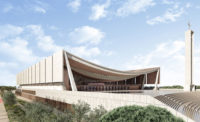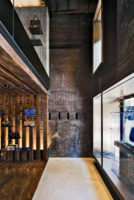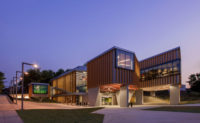In the icy outskirts of Moscow lies a massive new complex: one part academic institution, one part alien mother ship. Designed by London- and Berlin-based Adjaye Associates, the Moscow School of Management, Skolkovo, is a 460,000-square-foot megastructure that contains all the usual facets of campus life—classrooms, lecture halls, a cafeteria, and a 660-seat auditorium, among others—in a series of interconnected buildings. In 2006, in conjunction with a state-led, Vladimir Putin'endorsed push to make Moscow a prominent center of world trade, a contingent of Russia’s wealthiest businessmen—including magnate Roman Abramovich, the world’s 53rd richest person—launched the initiative to establish Skolkovo. Four years and $250 million later, a new university had risen.
The central structure is a poured-in-place concrete disc 475 feet in diameter that houses academic and recreational facilities. Entrances and parking are tucked beneath the disc on the ground level, allowing visitors to avoid the cold by driving into a garage-like enclosure. The customary campus green, fine for more temperate climates, is replaced at Skolkovo by interstitial spaces between “teaching units” that are used for informal gathering and exhibiting student work. Four boxy volumes of varying sizes, clad in a mosaic of colored aluminum-composite panels, sit atop this base. These blocks are largely filled with residential spaces, including 123 dormitory-style student suites and a 126-room hotel for visitors. One of the four rectilinear structures, distinguished from its comrades by golden aluminum cladding, contains athletic facilities, including a gymnasium and fitness center.
Though the school was built with Russia’s future in mind, the scheme of principal David Adjaye owes much of its form and shape to the country’s past: The building recalls the outsized, geometric modernism of 1920s- and ’30s- Constructivist architecture in the former Soviet Union. As in Vladimir Tatlin’s seminal Monument to the Third International (1920), an unbuilt proposal for an iron-and-steel government office tower in St. Petersburg, each function in Adjaye’s business school is given discrete real estate.
But Adjaye points to a different source of inspiration: the work of Russian Suprematist painter Kazimir Malevich. Malevich’s radical paintings of the early twentieth century featured color-blocked squares, circles, and rectangles, arranged in a deceptively helter-skelter way that belied the artist’s attention to detail. The disc and rectangular volumes at Skolkovo were composed in homage to his work.
By breaking up the mass, creating a dynamic, graphic facade, and designing spacious, light-filled interior spaces, Adjaye demonstrates that enormous structures need not be unwieldy. In his hands, this spacecraft of a school just might take flight.

















Post a comment to this article
Report Abusive Comment